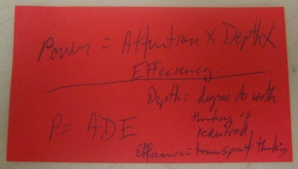 I had a good day at the LEAD-IT conference, where school district teams, consisting of a superintendent, tech director, tech integrator, and school board member from across Vermont are meeting and working together to write action plans for moving their schools into the 21st century. There were lots of conversations and an excellent presentation on education and project-based learning from Jim Moulton during the day. Yesterday evening, Bernie Dodge did a great presentation about technology trends and learning with technology. He described his formula for learning power:
I had a good day at the LEAD-IT conference, where school district teams, consisting of a superintendent, tech director, tech integrator, and school board member from across Vermont are meeting and working together to write action plans for moving their schools into the 21st century. There were lots of conversations and an excellent presentation on education and project-based learning from Jim Moulton during the day. Yesterday evening, Bernie Dodge did a great presentation about technology trends and learning with technology. He described his formula for learning power:
 |
| My notes from Bernie Dodge’s presentation… |
Wesley Fryer recorded the notes much more clearly in his January 10 blogged notes on a Bernie Dodge presentation, Engaging Brains Through Games and Simulations by Bernie Dodge. After that, he and Jim Moulton and I did a panel discussion, that, quite frankly, amazed me. It was 9:30 PM already, we’d just eaten huge dinner, and sat through an hour-long presentation. I think it’s a testament to Bernie’s performance that so many people wanted to ask so many very thoughtful questions. They were questions about ethics and information, evaluating the flood of content, school governance (that was a toughie), the new NETS, and many more. I left energized — then I crashed in my dorm room.
I think that the high point of the day was a conversation I had with Jim Moulton. I’m not sure that he was a social studies teacher, but that’s what we were talking about, how history seems so irrelevant to students, and that merely saying that we learn from the lessons of the past means almost nothing to them. Then this idea hit us both, one that probably occurrs to every history teacher, but…
Why not start your first day of class, asking students to read the news paper and then come back with on question. Use recent history to answer the question(s), but present the recent history in a way that it provokes more questions, that call for more history.
Maybe it’s the Vermont air!

Many years ago 8th grade teachers in my school district started teaching history backwards, integrating several novels of the various time periods in reading as well. I believe they still do it that way.
This is a great idea. We teach the history of Maryland in our 4th grade Social Studies curriculum. I tried to implement this a few years ago, only to hear that I had to follow the pacing guide. I argued that I would follow the pacing guide backwards, they didn’t see the point. From then on, I figured out that what the administration doesn’t know benefits my students!!
History backwards would be great if teachers didn’t have some ridgid assessment system that dictated the traditional system. In my history classes I always tell students that we study history to understand how we got to where we are. The systems however asks students to trust the teacher and wait a while for the pay off. On another note, the Vermont air is wonderful, I miss it a lot.
We don’t teach history backwards for the same reason that we don’t build a house starting with the roof.
One can inject relevance – the key problem facing a teacher wishing to engage his students in the study of history – without starting from today and working backwards.
I love this idea, but those tests popped up in my mind, both state and AP, etc. How about using a backwards history moment for a quick write, a blog, etc. to start or end the class in a history class? History can meet in the middle of the year, around Christmas time? I’m the school librarian, and I’m going to share this idea with my social science dept. I haven’t figured out a way to do this from the library. Yet.
My high school US history class was my all time favorite(1972). As I look back, the class was years ahead of it’s time. It was a called something like a “Topical Approach to U.S. History.” On the first day of class, our teacher asked us what we wanted to learn. And, believe it or not, we collaboratively created our syllabus for the year that began with the current events and worked backwards. I can remember our discussions about previous classes studying US History that never progressed beyond WWI since the year ended and the book was never finished. By starting at the present and working backwards, we worked to figure out how and why things were the way they were. The entire course was project-based (for instance, we held mock conventions when we studied the elections) and teams of students worked on classroom presentations such as “the decades” — where each team got to choose a time (the 50s, 60s, etc.) For our presentations, we created 35 mm slides by photographing pictures in magazines using a special camera stand, or by drawing on cells. We recorded music from vinyl onto cassette tapes and crudely edited them by stopping and starting the music on the phonograph. Can you imagine what we could have done with today’s technology?!! The teacher challenged our learning by providing every assessment in essay form. No bubble sheets, just 5 thought-provoking questions.
Could this class be taught the same today?